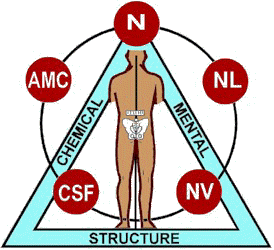 Applied Kinesiology
Applied Kinesiology
![]()
Applied kinesiology (AK) is the study of muscles and the relationship of muscle strength to health. This alternative medicine technique relies on the idea that muscles can be stuck (turned) "on" or stuck (turned) off." A stuck 'on' muscle acts like a tense muscle spasm ('charlie horse'), whereas a stuck 'off' muscle appears flaccid.
Applied kinesiology determines health imbalances in the body's organs and glands by identifying weaknesses in specific muscles that are linked by meridians. Stimulating and relaxing key muscles help in the diagnosis of variety of health problems.
AK recognizes the existence of "strong" and "weak" muscles. Weak muscles exhibit as much actual force as normal muscles. Weak muscles often have delayed reactions to stimuli. Studies suggest the difference between weak and strong muscles lies in the timing of electrical activity in the muscle. Muscles become weak due to immobility (i.e. cast), lack of exercise, poor posture, gland or organ dysfunction, or injury.
AK is based on muscle testing techniques through which weaknesses are identified and treated, thereby correcting imbalances in the body's energy systems.
Applied kinesiology is a relatively new alternative medicine field of study, diagnosis, and treatment. George Goodheart, D.C., of Detroit, Michigan, a chiropractic physician and the founder of applied kinesiology, first observed in 1964 that the absence of skeletal deformity and postural distortion is often associated with muscular dysfunction. The field has gained recognition, credibility, and a general following ever since his findings were revealed. He discovered that some of the standard muscle tests he used provided clues to the workings of the entire body. Goodheart went on to teach his findings to other Chiropractors.
The assumption used to be that the main muscular trouble-makers in back-ache and associated disorders were muscles which were either in spasm or too taut, thus affecting the spine. In the mid-1960's, however, Goodheart began to work on a different idea. It might not be muscle tension or tautness that was responsible, he surmised, but that it was "weak muscles on the opposite side (of the body) which caused the normal muscles to seem to be, or to become, tight. " Combining Eastern ideas about energy flow with his own Chiropractic techniques and other sources, Goodheart developed his new system in which muscle activation techniques are used to correct imbalances which have been identified by a method of muscle testing.
The distinguishing characteristic of AK, then, is the search for muscle imbalance so that it can be corrected. Clues will be looked for in the taking of your case history - Kinesiologists often find that symptoms are related to muscle weakness - headaches for example can be traced back to problems with the neck muscles. The aim, however, is not so much to correct individual weaknesses as it is to restore balance to the body.
Muscle tests are carried out while you are lying down. The doctor usually works first on one side of the body and then the other to detect the differences. Tiny imbalances of muscle tone will be corrected as they are found by using touch or pressure on the appropriate points.
![]()
| More about AK |
Design by: Joe Martin .
Copyright © 1999 Joe Martin. All rights reserved.
Revised: June 16, 2011.
HOME
Services
Location
Staff
Massage
Kinesiology
Articles
Associations